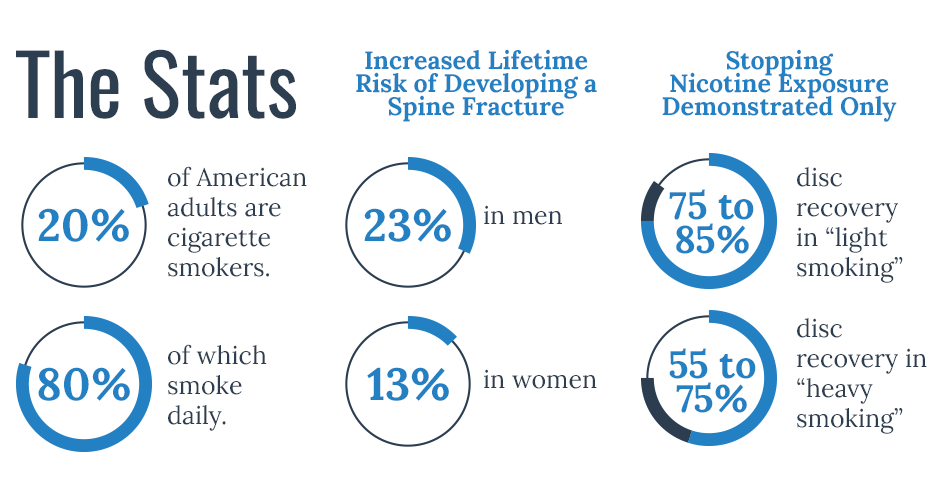20 percent of American adults are cigarette smokers. Of these individuals, about 80 percent smoke daily. Cigarette smoke has been found to contain over 4,700 chemical substances with the most notable being nicotine. Nicotine in cigarettes, e-cigarettes, vapes, oral tobacco and even nicotine patches all contain carcinogenic substances such as hydrocarbons and tobacco-specific nitrosamines (TSNA). Nicotine use is the most preventable form of cancer and death known to mankind.
Although less significant than cancer, nicotine use has been linked to spine problems on multiple levels. Absolutely no level of nicotine negates these risks, and therefore the only way to avoid this is complete cessation of nicotine-containing substances.
Osteoporosis
The first suggestion that smoking may be linked to osteoporosis dates back to 1976. Since then, it has been confirmed by numerous papers. Nicotine affects hormone levels, vitamin D and calcium absorption, blood vessel constriction and bone oxygen supply. In fact, nicotine opposes estrogen and stimulates earlier menopause in women. Smoking lowers testosterone levels. It also instigates chronic inflammation. Through these effects, nicotine promotes osteoporosis or weakening of bones. This increases the rate of fractures both in the spine and throughout the body. Women smoking more than one pack per day throughout adulthood have an average of five to ten percent lower bone density than non-smokers. Even second-hand smoke affects bone mineral density. Smoking causes an increased lifetime risk of developing a spine fracture by 32 percent in men and 13 percent in women.
Disc Degeneration
A normal disc is composed of a central “jelly-like” portion called the nucleus and outer rings of fibers called the annulus. Nicotine damages both the annulus and nucleus of the intervertebral disc. It appears that a normal disc, under normal wear and tear, develops small injuries called fissures, and these continually repair themselves. Studies indicate that nicotine decreases the disc’s ability to regenerate its injured cells. Additionally, nicotine decreases blood flow and blocks oxygen transport to the disc (which already has minimal blood supply). This starves the disc of nutrients leading to disc degeneration. Disc degeneration may be an independent cause of pain and instability of the spine. Therefore, smokers damage healthy discs and accelerate damage to already degenerating discs. In cellular studies, stopping nicotine exposure demonstrated only 75-85 percent disc recovery in “light smoking” and 55-75 percent disc recovery in “heavy smoking” groups at one year. And while quitting smoking has been linked to improved back pain, restoration of the nicotine-degenerated disc is minimal.

Spine Instability
Nicotine accelerates degeneration of discs which leads to abnormal motion of the spine. However, smoking also degenerates muscles, ligaments and tendons leading to further spine instability. Studies have shown that smoking 100 grams of tobacco per week resulted in a 2.9 percent to 5.0 percent decrease in quadriceps strength. Structural damage and loss of muscle mass has also been identified. Independently, muscle pain is also increased. In patients who underwent rotator cuff repairs, smoking was associated with increased severity of tears. Smoking is also a strong risk factor for tendon rupture and decreased rate of tendon repair.
Sensitivity to Pain
Smoking increases sensitivity to pain by altering the perception of pain through the neuroendocrine system. Smokers who have spinal symptoms for the same amount of time as non-smokers report symptoms as more severe and present for a greater percentage of time each day.
Studies have shown that smokers are less likely to have attended college or currently be married. Smokers are more likely to be extremely dissatisfied with the current health status and less likely to be optimistic about returning to their previous lifestyle. The rate of being depressed for more than two years of their life is substantially higher amongst smokers.
Surgical Healing
Nicotine impairs collagen formation which impairs the body’s ability to heal the skin and tissues. Not only is the blood supply limited, but there are increased levels of toxic chemicals including carbon monoxide which prevents collagen synthesis.
Fusion
Numerous animal models have shown that nicotine inhibits fusion. Nicotine has been shown to decrease blood flow in existing blood vessels to bone, decrease the formation of new blood vessels and produce molecules that inhibit the formation of bone. It delays bone incorporation specifically around metal implants, which is what is used in spine fusions. In humans models, smoking has showed delayed healing with fractures.








